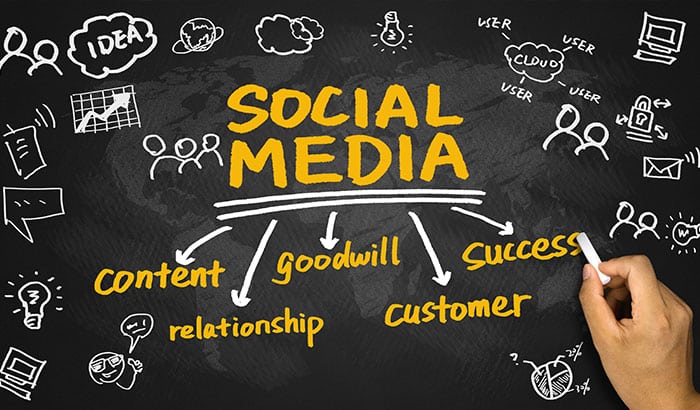In today’s world, social media is essential for businesses looking to grow and reach new audiences. With billions of users worldwide, it is a powerful marketing platform that allows companies to engage with customers and build brand awareness. However, deciding which channels to focus on can be difficult with so many social media options available.
Additionally, businesses also face the decision of whether to invest in organic social media efforts or paid media campaigns. This blog post will explore the differences between organic social media and paid media and help you decide which is best for your business.
What is Organic Social Media?
Organic social media is the process of building and maintaining a social media presence through organic means, such as creating engaging content and interacting with your audience. This approach involves using social media platforms like Facebook, Twitter, Instagram, and LinkedIn to post regular updates, share industry news, and connect with followers. Organic social media can build brand awareness, increase engagement, and foster customer loyalty.
One of the primary advantages of organic social media is that it is cost-effective. Posting updates and engaging with followers on social media is free, so you don’t have to spend money to build your presence.
Additionally, organic social media can be an excellent way to establish a personal connection with your audience. Posting interesting content and responding to comments can build trust and rapport with your followers, increasing brand loyalty and sales.
However, one of the downsides of organic social media is that it can be time-consuming.
Posting regular updates and engaging with followers takes time and effort. Building a significant following can be challenging without investing much time into your social media efforts. Additionally, organic social media is subject to algorithm changes, impacting your posts’ reach and overall visibility on the platform.
What is Paid Media?
Paid media, on the other hand, is the process of using advertising to promote your brand and reach new audiences. This approach involves investing money in advertising campaigns on social media platforms, search engines, or other online channels. Paid media can be an effective way to reach a large audience quickly and generate leads and sales.
One of the primary advantages of paid media is that it offers a high degree of targeting and control. With paid media, you can create highly targeted campaigns that reach specific audiences based on their interests, behaviors, and demographics. Additionally, paid media offers real-time analytics, which means that you can monitor the effectiveness of your campaigns and make adjustments as needed.
However, one of the downsides of paid media is that it can be expensive. Advertising campaigns can quickly add up, especially if you are targeting a large audience. Additionally, paid media can be less effective than organic social media in building long-term brand awareness.
Which One Should You Focus On?
So, the question remains: organic social media or paid media? The answer to this question depends on several factors, including your goals, budget, and resources.
Organic social media may be the best choice if you want to see long-term success. By posting regular updates, sharing industry news, and engaging with followers, you can build trust and loyalty over time.
Ultimately, the best approach for your business may be a combination of both organic social media and paid media. By leveraging the strengths of each approach, you can create a comprehensive marketing strategy that reaches a broad audience, builds brand awareness, and drives sales.
Here are a few tips to help you get started:
- Define your goals: Before you invest in organic social media or paid media, it is essential to define your goals. What are you looking to achieve? Are you trying to build brand awareness, generate leads, or increase sales? Understanding your goals will help you determine the best approach for your business.
- Know your audience: Understanding your target audience is essential for organic social media and paid media. Who are you trying to reach? What are their interests, behaviors, and demographics? Understanding your audience can create more effective campaigns that resonate with your target market.
- Develop a content strategy: Whether you are focusing on organic social media or paid media, it is essential to develop a content strategy. What type of content resonates with your target audience? What messaging is most effective? By developing a content strategy, you can create more engaging campaigns that drive results.
- Monitor and adjust: Whether you are investing in organic social media or paid media, monitoring your results and making adjustments as needed is important. What is working, and what isn’t? By monitoring your campaigns and making adjustments, you can optimize your results and achieve your goals.
Deciding whether to focus on organic social media or paid media is important for any business. While both approaches have their strengths and weaknesses, the best approach for your business will depend on your goals, budget, and resources. By combining the benefits of both approaches and creating a comprehensive marketing strategy, you will see better results.
Now that you have the common knowledge facts about organic social media and paid media, let’s take a look at some of the lesser-known facts about both.
Not-so-well-known facts about organic social:
- Organic reach on social media is declining: While organic social media can be a cost-effective way to build your brand, it’s important to understand that organic reach on social media is declining. In recent years, social media platforms have made significant changes to their algorithms, making it more difficult for businesses to reach their audiences without paying for advertising.
- Social media engagement rates are decreasing: In addition to declining organic reach, social media engagement rates are also decreasing. According to a study by Rival IQ, the average engagement rate for Instagram posts fell from 1.60% in 2019 to 1.22% in 2020. This means that it’s becoming increasingly difficult to engage your audience on social media without investing in paid media.
- The best time to post on social media varies by platform: The best time to post on Instagram is between 11:00 am and 1:00 pm on weekdays, while the best time to post on LinkedIn is between 10:00 am and 11:00 am on Tuesdays, Wednesdays, and Thursdays.
- Social media algorithms prioritize video content: If you want to increase your organic reach on social media, it’s worth considering incorporating video content into your strategy. Social media algorithms prioritize video content, which means that video posts are more likely to appear in users’ feeds than other types of content.
- User-generated content can be a powerful marketing tool: User-generated content (UGC) is content created by users that promotes a brand or product. UGC can be a powerful marketing tool, as it can help build brand awareness, increase engagement, and foster customer loyalty. According to a study by Stackla, 86% of consumers say that UGC is a good indicator of the quality of a brand or product.
Organic social media is the most commonly used source for reaching out to your target audience, but it’s important to understand that organic reach on social media is declining. By incorporating video content, posting at the right time, and understanding user-generated content, you can increase your organic reach and drive results on social media.
Next, let’s take a peek into the little-known facts about paid search media:
- Paid media can be used for branding: While many businesses use paid media for direct response marketing (i.e., driving traffic and conversions), paid media can also be used for branding. By running display ads and video ads, businesses can increase brand awareness and reach new audiences.
- Remarketing can be highly effective: Remarketing, which involves showing ads to people who have previously interacted with your website, can be highly effective. By targeting users who are already familiar with your brand and have shown interest in your products or services, you can increase the likelihood of them converting.
- Programmatic advertising is on the rise: Programmatic advertising, which involves using automated technology to buy and place ads, is becoming increasingly popular. This technology allows businesses to target specific demographics and bid on ad inventory in real-time, increasing efficiency and effectiveness.
- Paid media can be targeted by behavior and interests: It can be targeted based on users’ browsing behavior and interests, allowing businesses to reach their target audience with greater precision. This type of targeting can be particularly effective for companies that have a deep understanding of their target audience.
- Ad fatigue can impact performance: Users may become tired of repeatedly seeing the same ads, leading to decreased performance. To combat ad fatigue, businesses can rotate their ads, test different ad formats, and regularly update their creative.
- The use of ad blockers is on the rise: The use of ad blockers, which prevent ads from being displayed to users, is on the rise. To combat this trend, businesses can use native advertising and sponsored content to reach users in a way that feels more organic and less intrusive.
Paid media can be a powerful tool for businesses looking to reach new audiences, drive traffic to their website, and generate leads. By understanding the nuances of paid media and optimizing your campaigns, you can achieve your marketing objectives and grow your business.
Getting the best of both worlds.
By combining both organic social media and paid search media, businesses can create a powerful marketing strategy that maximizes their reach, engages their audience, and drives results. For example, paid search media can be used to drive immediate traffic to a website, while organic social media can be used to engage with that traffic, gain the trust of followers, and foster brand advocacy.
Moreover, using both platforms can also help businesses diversify their marketing efforts, reduce their dependence on one platform, and improve their overall ROI. With the right mix of organic social media and paid search media, businesses can achieve their marketing objectives and drive long-term growth.
Elevate Your Social Media Game With Revity
Do you need help keeping up with the world of social media marketing? Do you need help crafting the perfect social media strategy for your business? Let Revity help.
Our expertise and experience can help turn your social media marketing into an indispensable tool for your business. Contact us today to learn more about how we can help you achieve your marketing goals.







